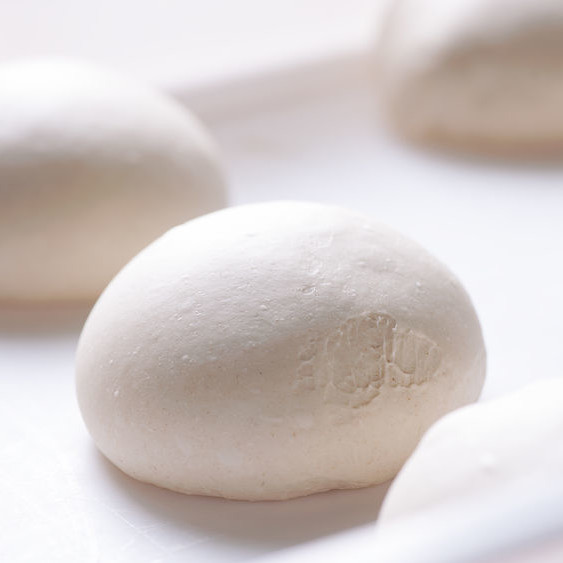
Dough Conditioners
Also known as dough improvers or strengtheners
What are Dough Conditioners?
Dough conditioners are ingredients that improve dough processing, as well as the overall quality of baked products in high-speed production environments. They are available as concentrates or dry mixes. Most often, they’re found in no time dough/straight dough systems.
Dough conditioners usually contain multiple individual ingredients for specific functions. Some examples are:
- pH regulators
- Mineral yeast food
- Enzymes
- Redox agents
- Emulsifiers
- Vital wheat gluten (VWG)
Origin
In the 1950s, the first dough conditioners came on the market in the form of pastes and liquid preparations. Then, powdered versions followed shortly after. These allowed for easier dosing and accurate scaling. In the 1980s, advances in functional enzymes became a key focus for improving dough handling and bread properties.
Function
Dough conditioners can help improve:1
- Dough handling properties
- Gas production by yeast
- Gas retention by gluten matrix
- Volume of baked goods
- Crumb structure and texture
- Crust development and color
- Product general appearance and symmetry
- Sliceability of the baked product
- Shelf-life by delaying the onset of staling
Nutrition and health
Dough conditioners have a technological function in the dough. They are considered processing aids. So, they are present in minute amounts in the finished product. Dough conditioners do not contribute to nutrients or caloric content in human diet.2 However, vital wheat gluten adds some protein. 1 g of VWG provides 0.6 g of protein.
Clean label trends in food has spurred high-speed bakers to use alternative ingredients. So, clean label dough conditioning options include organic acids, natural reducing and oxidizing agents, hydrolases and long dough fermentations.
Commercial production
Dough conditioners are produced as fine, food-grade ingredients. For example, enzymes can be produced through industrial fermentations using food-grade microorganisms such as bacteria and fungi. They can also be extracted and purified from animal or plant sources. However, they are more expensive than their chemical-based counterparts.3
Application
Dough conditioners help with:
- Consistent outcome and quality
- Mechanical dough processing
- Optimizing the supply chain
Dough conditioner mixes are usually added at 0.5–4.0%, based on flour weight. Whole wheat and high fiber breads generally require higher amounts of dough conditioners. This is to compensate for their lack of proper gluten development, and for optimum dough handling properties.
Challenges with dough formulations and process variations can be helped with dough conditioners. This is most critical when using yeast and sourdough, which are sensitive to changes in their environment.
Another important role of dough conditioners is compensating for fluctuating wheat flour quality. New harvests, weather or milling processes can create inconsistent outcome and quality issues. Using dough conditioners helps improve the flour tolerance against these fluctuations and ensures a more constant output with less waste.
FDA Regulation
Dough conditioners are regulated by the FDA in the United States as to maximum usage levels, approved sources, and production methods.1,4,5
| Group | Considerations |
| Enzymes | According to 21 CFR Part 184 (Direct Food Substances Affirmed as Generally Recognized as Safe), these ingredients can be used in food in amounts sufficient for the purpose, with no limitation other than current good manufacturing practices. |
| Emulsifiers: Dough strengtheners | According to 21 CFR Parts 172, 182 and 184, some are limited only by good manufacturing practices; others are allowed at levels required to produce the intended effect. Some may also have specified limits on their use. |
| Emulsifiers: Crumb softeners | |
| Oxidizing agents | According to 21 CFR Parts 170, 182 and 184, most oxidizing agents have limits on their use in food products. |
| Reducing agents | According to 21 CFR Parts 170, 182 and 184, most reducing agents are GRAS given their natural origin. |
References
- Cauvain, S.P. “Functional Ingredients.” Technology of Breadmaking, 3rd edition, Springer International Publishing Switzerland, 2015, pp. 57–97.
- U.S. Food and Drug Administration, CFR – Code of Federal Regulations Title 21, Part 101: Food Labeling https://www.accessdata.fda.gov/scripts/cdrh/cfdocs/cfcfr/CFRSearch.cfm?fr=101.100. Accessed 25 May 2019.
- Smith, J., and Hong-Shum, L. Food Additives Data Book, 2nd edition, Blackwell Publishing Ltd, 2011.
- U.S. Food and Drug Administration. “21 CFR 182 – Substances Generally Recognized As Safe.” 1 Apr. 2017, https://www.accessdata.fda.gov/scripts/cdrh/cfdocs/cfcfr/CFRSearch.cfm?CFRPart=182. Accessed 2 December 2018.
- U.S. Food and Drug Administration. “21 CFR 184 – Direct Food Substances Affirmed As Generally Recognized As Safe.” 1 Apr. 2017, https://www.accessdata.fda.gov/scripts/cdrh/cfdocs/cfcfr/CFRSearch.cfm?CFRPart=184. Accessed 2 December 2018.
- Colakoglu, A and Özkaya, H. “Potential use of exogenous lipases for DATEM replacement to modify the rheological and thermal properties of wheat flour dough.” Journal of Cereal Science,Volume 55, Issue 3, 2012, ISSN 0733-5210. https://www.sciencedirect.com/science/article/abs/pii/S0733521012000422?fbclid=IwAR170KE53BredxMO0ENJJyJPS8TGD6k1nhcoRYvQDgnkO6jlxqfkoIkVIcE

